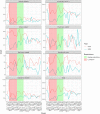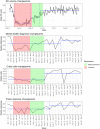A multicenter study of short-term changes in mental health emergency services use during lockdown in Kitchener-Waterloo, Ontario during the COVID-19 pandemic
- PMID: 34635077
- PMCID: PMC8505015
- DOI: 10.1186/s12889-021-11807-4
A multicenter study of short-term changes in mental health emergency services use during lockdown in Kitchener-Waterloo, Ontario during the COVID-19 pandemic
Abstract
Background: The COVID-19 pandemic and subsequent lockdown measures have led to increasing mental health concerns in the general population. We aimed to assess the short-term impact of the pandemic lockdown on mental health emergency services use in the Kitchener-Waterloo region of Ontario, Canada.
Methods: We conducted an observational study during the 6-month period between March 5 and September 5, 2020 using National Ambulatory Care Reporting System metadata from mental health visits to three regional Emergency Departments (ED); mental health and substance related police calls; and calls to a regional mental health crisis telephone line, comparing volumes during the pandemic lockdown with the same period in 2019. Quasi-Poisson regressions were used to determine significant differences between numbers of each visit or call type during the lockdown period versus the previous year. Significant changes in ED visits, mental health diagnoses, police responses, and calls to the crisis line from March 5 to September 5, 2020 were examined using changepoint analyses.
Results: Involuntary admissions, substance related visits, mood related visits, situational crisis visits, and self-harm related mental health visits to the EDs were significantly reduced during the lockdown period compared to the year before. Psychosis-related and alcohol-related visits were not significantly reduced. Among police calls, suicide attempts were significantly decreased during the period of lockdown, but intoxication, assault, and domestic disputes were not significantly different. Mental health crisis telephone calls were significantly decreased during the lockdown period. There was a significant increase in weekly mental health diagnoses starting in the week of July 12 - July 18. There was a significant increase in crisis calls starting in the week of May 31 - June 6, the same week that many guidelines, such as gathering restrictions, were eased. There was a significant increase in weekly police responses starting in the week of June 14 - June 20.
Conclusions: Contrary to our hypothesis, the decrease in most types of mental health ED visits, mental health and substance-related police calls, and mental health crisis calls largely mirrored the overall decline in emergency services usage during the lockdown period. This finding is unexpected in the context of increased attention to acutely deteriorating mental health during the COVID-19 pandemic.
Keywords: COVID-19; Lockdown; Pandemic; Psychiatric emergency.
© 2021. The Author(s).
Conflict of interest statement
The authors declare that they have no competing interests.
Figures




Similar articles
-
Psychiatric emergency admissions during and after COVID-19 lockdown: short-term impact and long-term implications on mental health.BMC Psychiatry. 2021 Sep 24;21(1):465. doi: 10.1186/s12888-021-03469-8. BMC Psychiatry. 2021. PMID: 34560856 Free PMC article.
-
Acute mental health service use following onset of the COVID-19 pandemic in Ontario, Canada: a trend analysis.CMAJ Open. 2021 Nov 16;9(4):E988-E997. doi: 10.9778/cmajo.20210100. Print 2021 Oct-Dec. CMAJ Open. 2021. PMID: 34785528 Free PMC article.
-
The impact of lockdown on pediatric ED visits and hospital admissions during the COVID19 pandemic: a multicenter analysis and review of the literature.Eur J Pediatr. 2021 Jul;180(7):2271-2279. doi: 10.1007/s00431-021-04015-0. Epub 2021 Mar 15. Eur J Pediatr. 2021. PMID: 33723971 Free PMC article. Review.
-
Physician Health Care Visits for Mental Health and Substance Use During the COVID-19 Pandemic in Ontario, Canada.JAMA Netw Open. 2022 Jan 4;5(1):e2143160. doi: 10.1001/jamanetworkopen.2021.43160. JAMA Netw Open. 2022. PMID: 35061041 Free PMC article.
-
How emergency department visits for substance use disorders have evolved during the early COVID-19 pandemic.J Subst Abuse Treat. 2021 Oct;129:108391. doi: 10.1016/j.jsat.2021.108391. Epub 2021 Apr 9. J Subst Abuse Treat. 2021. PMID: 33994360 Free PMC article. Review.
Cited by
-
Trends in visits to a 24-hour walk-in crisis mental health centre during the COVID-19 pandemic.Front Health Serv. 2025 Jul 2;5:1416164. doi: 10.3389/frhs.2025.1416164. eCollection 2025. Front Health Serv. 2025. PMID: 40671848 Free PMC article.
-
Scrolling Through the COVID-19 Pandemic: Exploring the Perceived Effects of Increased Social Media Use on the Mental Health of Undergraduate University Students.Soc Media Soc. 2023 Jun 13;9(2):20563051231177970. doi: 10.1177/20563051231177970. eCollection 2023 Apr-Jun. Soc Media Soc. 2023. PMID: 37337522 Free PMC article.
-
Changes in psychiatric admissions in the first year of COVID-19 in Ontario, Canada.Int J Ment Health Syst. 2025 Jun 3;19(1):18. doi: 10.1186/s13033-025-00674-w. Int J Ment Health Syst. 2025. PMID: 40457388 Free PMC article.
-
Changes and Challenges in Inpatient Mental Health Care During the First Two High Incidence Phases of the COVID-19 Pandemic in Germany - Results From the COVID Ψ Psychiatry Survey.Front Psychiatry. 2022 Apr 27;13:855040. doi: 10.3389/fpsyt.2022.855040. eCollection 2022. Front Psychiatry. 2022. PMID: 35573380 Free PMC article.
-
Outpatient mental health care during high incidence phases of the COVID-19 pandemic in Germany - changes in utilization, challenges and post-COVID care.Eur Arch Psychiatry Clin Neurosci. 2024 Dec;274(8):2025-2035. doi: 10.1007/s00406-024-01886-w. Epub 2024 Sep 1. Eur Arch Psychiatry Clin Neurosci. 2024. PMID: 39218918 Free PMC article.
References
-
- Ferguson NM, Laydon D, Nedjati-Gilani G, Imai N, Ainslie K, Baguelin M, et al. 2020. Impact of non-pharmaceutical interventions (NPIs) to reduce COVID19 mortality and healthcare demand. https://www.imperial.ac.uk/media/imperial-college/medicine/sph/ide/gida-...
-
- Flaxman S, Mishra S, Gandy A, et al. Estimating the number of infections and the impact of non-pharmaceutical interventions on COVID-19 in 11 European countries. Imperial College COVID-19 Response Team. 2020.
Publication types
MeSH terms
LinkOut - more resources
Full Text Sources
Medical
Miscellaneous

